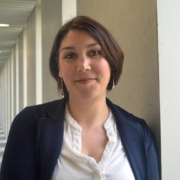“Industrial safety is difficult to understand because it is implicitly defined more by its absence – of adverse events in this case – than by its presence. Yet it is inextricably linked to work activities and working conditions, which can be studied.” This the task sociologist Stéphanie Tillement has accepted in her role as a researcher at IMT Atlantique and head of the Research in Safety, Organization and Humans (RESOH) chair, which explores the organizational factors involved in safety, particularly in the nuclear industry.
According to the researcher, there are two approaches to studying industrial risk: “Either we analyze why an organization collapses, the dynamics that lead to an accident, or we try to understand the reasons for its success!” The RESOH Chair project focuses on this second approach: studying industries’ ordinary operations to understand the foundations of their organizational robustness and resilience. “Although the organizations studied are complex, with high ‘catastrophic’ potential, we have observed that they manage to operate on a daily basis without any major incidents,” Stéphanie Tillement says.
November 2023 marked the official renewal of this Chair for its third 5-year term, with an updated vision including a new consortium and research themes adapted to current challenges. “For each renewal, we adapt the research questions to the context and societal and industrial developments to ensure the project matches the concerns of its day,” the researcher said.
Partners involved in the research process
The RESOH Chair was first set up in 2012, shortly after the nuclear accident at the Fukushima Daiichi power plant. At the time, safety was a central concern for high-risk industries. The Chair specifically examines the impacts of inter-organizational relationships: “The vulnerabilities are always found in the interstices,” Stéphanie Tillement says.
The researcher distinguishes two sensitive interfaces: between contractors and subcontractors, and between regulators and those regulated. To understand how the nature and quality of these relationships affect safety, the researcher and her team have conducted longitudinal studies at partner organizations.
The partners have changed over the course of renewals, based on changes in the socio-economic context and research topics. In 2023, the Commissariat for Atomic Energy and Alternative Energies (CEA) joined Naval Group in the consortium, and succeeded the Institute for Radiation Protection and Nuclear Safety (IRSN), Areva (now Orano) and the National Agency for Radioactive Waste Management (Andra). These partners are “strongly committed to the project,” Stéphanie Tillement says.
High-risk organizations: behind the scenes
According to the sociology researcher, observing the ordinary activities and situations the stakeholders experience is the starting point for understanding how safety is established on a daily basis. “Our investigative embedded approach presupposes inside access to organizations,” she says. Building and maintaining trust relationships with these organizations is therefore a major requirement for the Chair’s scientists.
This is sometimes a long but successful process: “once partners give us access to their sites, we can collect and triangulate field data, combining observations and interviews.” During the Chair’s second term, the teams conducted field investigations for five years at a nuclear plant. “It’s a privilege, compared to other security research teams, to gain this behind-the-scenes access to high-risk organizations,” says Stéphanie Tillement.
Strong inter-organizational relationships
These years of immersion, until now focused on understanding inter-organizational relations, led to two conclusions. First, the important role of doubt in the robustness of the interface between regulatory and regulated organizations. “The existence of space for less formal or bureaucratic dialogue, in which everyone can voice their doubts, open up about problems, contribute to an investigation process, and participate in organizational reliability,” the sociologist says. On the other hand, the researchers also observed that there was no strict determinism between outsourcing certain activities and security vulnerabilities.
The researcher highlights the need to recognize the nuances involved. “The term ‘subcontracting’ is used to describe very diverse realities that must be taken into account to analyze whether or not the subcontracting conditions impair safety.” These include the monitoring arrangements established, the powers ordering organizations maintain in order to control outsourced activities, and the existence of forums for discussion bringing together ordering parties and subcontractors. “We also observed vulnerabilities related to the nature of the relationships within the same organization, especially between maintenance and production. For example, organizational constraints and conflicts between performance indicators can prevent or greatly hinder any real trade-offs between maintenance and production. In the long term, this can affect safety, without it being the fault of subcontracting,” the researcher adds. “Inter-organizational relationships are important, but they should result in a disregard for intra-organizational boundaries, which are also worth examining.”
New scientific issues, adapted to current challenges
While the RESOH 3 Chair will maintain the same methodology as the first two terms, the context has nevertheless changed since the last renewal in 2017. The energy crisis, linked in particular to the conflict in Ukraine and fears of shortages, have brought the issues of sovereignty, independence and France’s reindustrialization back to the fore.
In response to these challenges, industrial organizations can fall prey to the increasingly demanding “faster, better, cheaper” approach, a slogan for which NASA has become famous. But is this approach compatible with safety? After the space agency – which maintains both institutional and technical authority – experienced the Challenger and Columbia disasters, it became clear that there was room for doubt. Safe industrial performance therefore remains a key research focus for the RESOH 3 Chair, to which new ones have been added. The desire to revive industrial activities goes hand in hand with essential training and recruitment challenges – particularly for the nuclear sector. There is therefore a new focus on skills and knowledge management.
The breakdown of knowledge
Maintaining, renewing and transferring skills between generations of workers does indeed pose major challenges. This is firstly due to the sector’s high level of socio-technical complexity: the expert skills required are not limited to simply performing tasks but are acquired over time, with experience. It is also linked to the fact that “these organizations are not subject to linear patterns but rather to peaks and troughs in their activities, especially in the civil nuclear industry,” Stéphanie Tillement explains.
In the 2000s, the rise of ecological concerns helped fuel the nuclear power revival, albeit timid, which in France led to launch of the Flamanville European pressurized reactor (EPR) project. Yet this came after a long period void of any nuclear design or construction activities since the end of the Messmer plan. Nearly fifteen years had passed since the end of the program launched in 1974, which had led to the commissioning of all the French reactors in operation today.
This interruption inevitably led to consequences which continue to plague the EPR project today. “The objectives of this program were very ambitious, despite the fact that the nuclear industry had largely ‘unlearned’ both cross-cutting and technical skills such as boiler making and welding. The industrial base was weakened and organizations faced a ‘learning wall’, to quote my colleague Frédéric Garcias. In addition, since only one EPR had been launched, they could not benefit from the series effect or returns on education,” the researcher says. The RESOH 3 Chair will therefore focus on how skills are (re)built and deployed within organizations, as well as organizations’ capacities to maintain them and pursue a long-term vision.
Teaching that promotes the transfer of research results
The Chair’s last – but not least – research focus is the design and engineering of systems for capitalizing on research results. “This aspect was given little attention or addressed at the very end of the project in previous chairs. Yet it is essential for partners to be able to take advantage of the results produced and take steps to change their practices,” Stéphanie Tillement says. The researcher aspires to a more dynamic and less formal format than the research transfer notes drafted during the second term, “which is why this objective has been added to the priorities for RESOH 3. But there is much to be done.”
She believes that it is a matter of implementing innovative measures to reach the strategic and operational levels. The studies and organizational knowledge and analysis they produce are intended to inform discussions on the links between work, industrial performance and safety. Finally, they will also help stakeholders – especially decision-makers at the highest levels – reconnect with the reality of work situations.






